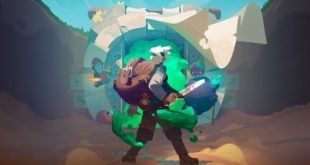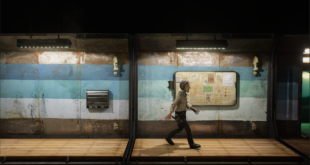One of the great things about the games industry is that it is replete with success stories from humble beginnings. 10 Second Ninja is one of those stories. If you’ve never played it or its sequel, as a ninja you have 10 seconds to complete incrementally challenging platform puzzle levels.
Armed only with a sword and a limited number of shurikens, you must navigate the deadly environments in the quickest time possible to earn a star rating.
I felt like, up until this point, we’ve been lagging a bit behind where industry trends are going. It looks like indie games are heading towards a mid-tier now
“I started 10 Second Ninja when I was in sixth form,” explains the games’ creator, Dan Pearce. “It was about two years after winning at BAFTA’s Young Games Designers awards in 2010. I’d done quite a few tours of studios and through that I was able to do work experience. I pretty quickly decided that there was a lot I liked about that triple-A style of development, but there was a lot that irked me."
The early part of the decade was a tulmultuous one with many studios closing. “Junior members are the easiest to get rid of. It seemed like that big budget side of games was about to enter quite a lot of turbulence, which ended up being the case.”
As studios closed, solo development became the go-to move for veterans. But it was also equally important for younger game developers to get experience, as Pearce remembers. “Indie Game: The Movie had just come out, so I was very inspired by that. In hindsight I’m not sure how much that was good for me. There was a big Indie renaissance going on and I said to myself, ‘Okay, here’s my ‘in’. I’ve got a few years before I really need to be looking for a job in games. If I make something polished and commercial, that’s going to showcase my skillset a lot better than a bunch of prototupes or design work."
NINJA TRAINING
The road to developing a prototype started very early on, while Pearce was still in education. “I showed it to a few of my friends. They got really competitive with it, so I knew there was something in it. I developed that over two or three years through university, which I dropped out of after a year. I gradually polished it up more and more.”
“I restarted that game three times with different art styles. It was a long process. You tend to hear developers say stuff like, ‘Oh yeah, usually you’ll fail ten projects before you get the one that works.’ 10 Second Ninja was all of those at once. I knew people liked the core concept, so I kept going back to it for a few years. I took it to Game City and other shows and I got better at talking about the game."
By the time I got to the end of my first year at university I knew I was going to release 10 Second Ninja in a matter of months. I hated university. I dropped out and made a deal with my parents to support me for a short time.”
TEACH ME, SENSEI
“I was born in ‘94,” explains Pearce. “So by the time I was starting to really get into games, 3D was the standard and every game was trying to be 3D in some way. Obviously there were 2D games I played when I was growing up, but there weren’t a lot of them. It wasn’t the norm. So that style of game design was a little bit alien to me.
“Having this indie renaissance with Newgrounds and Xbox Live Arcade was like discovering a new genre. It was a really refreshing experience, playing Super Meat Boy and Castle Crashers. Realising games could be designed in that way and how much more accessible that style of game development is, was really huge for me. 10 Second Ninja was definitely a reflection of that.”
Time limits are still in modern day games, but the in-game importance of the mechanic hasn’t been as prominent in the last decade. “Super Mario Bros. had a timer and also had lives,” says Pearce. “Those were two staples of that game that didn’t really benefit the experience at all, but that every game copied for about twenty years afterwards. I kept looking at these games and realising the way I am playing when I’m aware of the time constraint is much more interesting. I’m thinking about the space much more critically and I’m having a much more rewarding time.”
“It almost started off as sort of a joke. There are a lot of super hard trolling games. Why don’t I try that and see how it feels? It turns out that it wasn’t really trolling at all. It was actually really fun. Early prototypes sucked, but that core loop was really engaging.”
NINJA SOULS
It’s no secret that difficulty in games this decade has a benchmark and it is called Dark Souls. Any game that now presents a suitably high difficulty level seems to get labelled with the ‘Souls- Like’ tag. “People get stroppy about bringing up Dark Souls, but I think it’s valid,” says Pearce. “In Dark Souls, it’s very difficult, but it’s not so much about dexterity as it’s about forethought and rethinking critically about the mechanics that you’re using when you’re dodging and when you’re moving. It’s a very smart game and it expects the player to be smart, much more than it expects the player to be responsive with the controller.
“While 10 Second Ninja is obviously a much faster game, we do give the player a big window of time at the very start of the level where they can just look at it and go, ‘Okay, what’s my route? What do I have going for me? Is it quicker to use one of my three shurikens to hit that guy over there? Or is it quicker if I run up there and shuriken the guy on the other side of the level?’
“Everyone that plays is thinking about space critically. That’s what 90 per cent of games are. I have these abilities that interact with the space in these different ways. How do I solve this problem? It’s a super abstract way of looking at it. It’s easy to look at games as being too abstract in that way and lose the fantasy of it for a bit.
“On a mechanical level, it’s about thinking about space. But we also try to make sure it is also about dexterity and responsiveness and make sure that both of those elements are tied together by a core fantasy that is appealing. The fantasy of being a ninja for me is about being very quiet and still, looking at your environment, and then suddenly super fast, just zipping around, doing all this cool stuff. I feel like that’s a fantasy that’s very potent. I feel like, on a mechanical level, it made sense to combine those two things.”
REFLECTIONS
One of the poetic ironies about 10 Second Ninja and sequel 10 Second Ninja X is that what began as a way to showcase what Pearce could do is now used as a showcase for what his studio, Four Circle Interactive, can do. Things have changed though for Pearce and his career outlook.
“A fundamental problem, and this applies to 10 Second Ninja and 10 Second Ninja X, is that they were both really good games for two years before they came out. If they had come out in 2012 and 2014, I think they would have killed.
“I felt like, up until this point, we’ve been lagging a bit behind where industry trends are going. It looks like indie games are heading towards a mid-tier now. It’s not just two people in their bedrooms making games. It’s small teams. It’s moderate budget, like half a million combined marketing and development costs.
“It seems a bit like we’ve leapfrogged over about two years in what our company should have been doing, which is scary. To an extent, the bigger these products get, the more I slip into a producer role.
“If worst came to worst, and everything just went completely down for some reason, I feel like I could apply for a senior role in a different company, or a mid-role at a bigger company, and I would have the experience to follow through on that.
“That’s cool for me. I feel secure in what I’m doing and my skill set, which is nice, because the original goal with
all of this was I just wanted to make sure I could get a good junior position. Now I wouldn’t be happy with that, and I don’t think people would be getting the best out of me if I were in that situation. Hopefully that continues and I keep making a ladder for myself.”

 MCV/DEVELOP News, events, research and jobs from the games industry
MCV/DEVELOP News, events, research and jobs from the games industry




